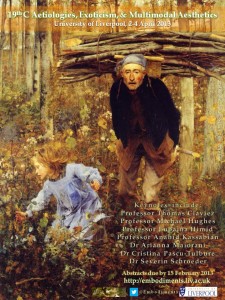Nineteenth-Century Aetiologies, Exoticism, and Multimodal Aesthetics
University of Liverpool, 2-4 April 2013
The encounter with the other always means the encounter with the unknown.
The unknown can be easily misperceived.
Langeveld, 1966
There is a primary understanding of nineteenth-century modes of impression, expression, and interpretation that predispose positive human connection as opposed to the psychology and philosophy of negativity before and after the Enlightenment. Nineteenth-century semiotic sources other than language are particularly read in separation from one another in different fields so much so that in postcolonial studies, for example, we do not see expression of multimodality in its realistic form. Rather we encounter an idealistic homage in its uni-modality, studying the mind and body of the ‘other’ through the intellectuality of the so-called
governing mind and body of the ‘self’.
Similarly in our contemporary conception of ‘aetiology’ and ‘exoticism’, it is possible to decode both terms as simple indications of ill and foreign origin. Scholarly focus on which aspect of these two terms is supposed to represent aesthetics of the long nineteenth century, at its best, has overlooked central concepts such as ‘otherness’ and ‘consciousness’ and their multimodal workings. If we think of various modes of expression during the long nineteenth century, we can find numerous examples of multimodal connectivity: think the combination of manuscript and print, the expression of otherness through impressions modulated in portraits, carpets, calligraphy, monuments, sculptures, music notes, printed narratives, … ; you will particularly recall William Blake and Jane Austen in Britain, the French Jean-Léon Gérôme, the Russian Ivan Aivazovsky, the Irish William Rowan Hamilton, the Persian Kamal-ol-Molk Mohammad Ghaffari and many others from different geographies who made and communicated meaning by combining various semiotic sources.
Today many literary and linguistics scholars claim that multimodality is a current academic development; its origins, historical prevalence, philosophical particularities in relation to ‘otherness’ are rarely discussed. There are, however, ongoing projects and a magnificent body of work produced by scholars who connect aesthetics and stylistics both historically and psychologically, e.g. Joe Bray (Sheffield), Adrian Førde Andersson (Agder), Arianna Maiorani (Loughborough), Bjarne Markussen (Agder), Peter Stockwell (Nottingham), Andrew Wilson
(Lancaster), to name but a few. Drawing upon the writings of these and other researchers, the conference aims to address historical conceptions, communications, and meaning-makings of ‘otherness’. We will discuss the significance of nineteenthcentury consciousness, various modes of communication interlinked through the 19th-C Aetiologies, Exoticism, and Multimodal complexity of symbols, icons, narratives, theories, etc. that remain difficult to decipher, especially in transition from one domain to another. Contributions in the following areas are particularly welcome:
- Identity, Portraiture, Performance
- History, Otherness, Aetiology
- Consciousness and the Narrative Style
- Nineteenth Century Mind-Body Relations
- Multimodality in Historical and Philosophical Contexts
- Multimodal Aesthetics
Keynotes include:
Professor Thomas Claviez, University of Berne
Professor Lubaina Himid, University of central Lancashire
Professor Michael Hughes, University of Liverpool
Professor Anahid Kassabian, University of Liverpool
Dr Arianna Maiorani, University of Loughborough
Dr Cristina Pascu-Tulbure, University of Bangor
Dr Severin Schroeder, University of Reading
Submissions:
There will be two-three workshops during the conference and a book exhibition. A collection from selected presentations will be considered for publication as 2013 special issue of the International Journal of Literature and Psychology: http://literatureandpsychology.liv.ac.uk/ Also a volume of ‘Texts and Embodiments in Perspective’ book series will showcase key conference proceedings. To submit individual proposals for 20-minute papers + CV/Biog. note, and for panel proposals of up to three papers, each 20 minutes, email: painpara@liv.ac.uk
Two postgraduate bursaries will be available for daily attendance, memorial of Dr Wasfia Mhabak. Discounted registration fees will be available to members of Liverpool Embodiments Project.
Conference link:http://embodiments.liv.ac.uk/?page_id=1105
Abstract Deadline: 15 February 2013
Email:painpara@liv.ac.uk
